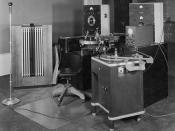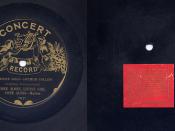Even though recording technology in 1931 had vastly improved, there were still some limitations to the quality of sound that is produced. Moving on from the physical to the electronic or the electrical technology, it proved to be a good improvement. Origins in telephony,
The track "Devil Got My Woman" recorded by Skip James in paramount was released in 1931. The technology at that time was that of electrical. The microphone had just been recently invented in 1924 and used in recording company. There were several advantages of using a microphone in recording. Sound engineers are now able to manipulate the sound recorded like getting rid of hiss and it also increases the volume and bass of the music. Such manipulation was impossible to do when music was recorded using the old acoustic technology of just using a horn for capturing vibrations.
One of the now overlooked limitations of the recording after 1927 was the fact of one microphone.
Whether a Wagnerian orchestra or a piano, the microphone was placed near the singer and the accompaniment was never the dynamic level we expect in a concert hall or opera house. The same limitations of about four minutes per record still obtained for electric recordings. In 1930 when Lehmann recorded her first Erlkönig, there is a rush to fit it all on one 10 inch disc when a 12 inch disc was needed. The pianist can't manage the triplets and the result is very disappointing. During the electric recording era there was also both frequency and amplitude loss, though not to the same extent as with acoustic recordings. When Lehmann (or others) sang a loud climax, the engineers turned down the volume to avoid distorting. They sometimes overdid this, short-changing us some wonderful moments, but they were doing the...


